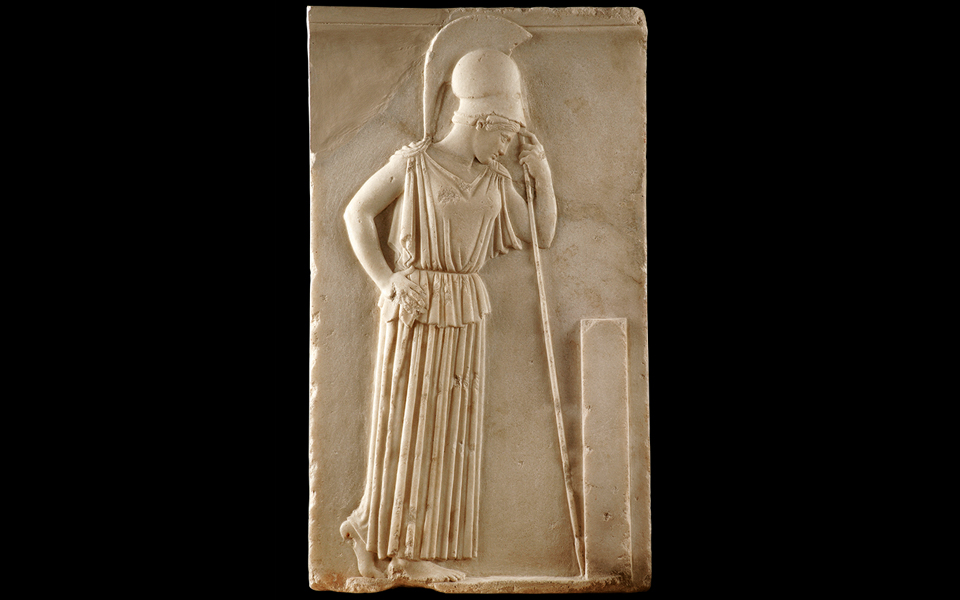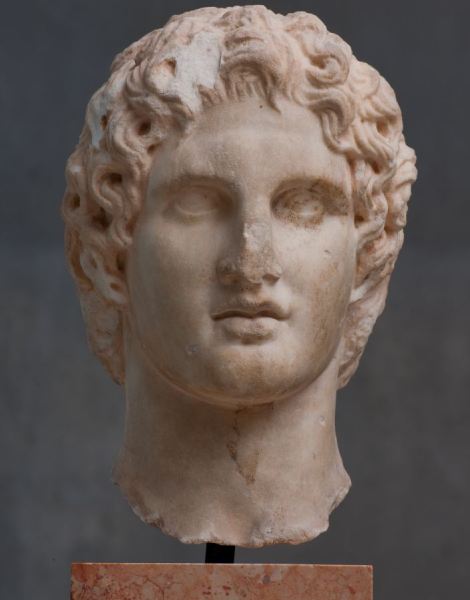Where to Eat & Drink in Neapoli, Athens
Between Strefi and Lycabettus Hills, Neapoli...

The "Triple-bodied monster"
© Vangelis Zavos
The doors are open! As of 15 June 2020, the Acropolis Museum is once again welcoming visitors to come in and experience the ancient treasures of the Acropolis.
With its subtle architectural hints at the actual topography of the ancient Sacred Rock – including its inclined Acropolis Slopes Gallery, its dedicatory statues standing amid numerous temple-evoking columns in the Archaic Acropolis Gallery and its precisely-dimensioned and oriented Parthenon Gallery reflective of the great Athena temple itself – the Acropolis Museum takes you on an upward journey of discovery.
From bearded sea serpents to smirking Athenian ladies, reverent calf-bearers and galloping riders, they are all here. These are no “virtual” objects, no strictly digital images… These statues and other relics are the Real Thing, already so familiar to many of us, from art textbooks or ubiquitous photos; yet standing in front of us, almost like old friends or family.
Here we find objects that live in our dreams, our collective imagination, our understanding of the world. We recognize and embrace them. But! Only with our eyes, since – as we do with our genuine fellow earthlings at the moment – we need to keep a “healthy” distance.
This is the joy of our newfound freedom: we can be together again, enjoy our world history, learn more about it and share its beauty and joy with each other. Plus, we are seeing these great masterpieces with our own eyes! Look, some of them are smiling! The “old friends” themselves seem to be welcoming us back.

The relief depicting Asclepius was a votive offering probably dedicated to the god as a token of gratitude after some treatment. It was found almost intact on the Makriyiannis plot.
Nothing could be more topical than these relief panels concerning public health from the Asklepieion, the sanctuary of the divine healer Asclepius, on the Acropolis’ South Slope. One sculpted scene (Acr. 1337, ca. 350 BC) depicts the healing god, with his wife Epione and daughter Hygeia, receiving a procession of worshipers led by a small slave with a sacrificial pig. Exhibited nearby are carved images (Acr. 1378, ca. 320 BC) of surgical instruments and traditional suction cups to be applied to the back.

The Triple-bodied monster
© Vangelis Zavos
Before the Parthenon, there was the Hekatompedon, perhaps the first temple of Athena Parthenos, built on the same spot some 100-120 years before the still-standing Periclean Parthenon. Preserved from its western pediment is the so-called Bluebeard daemon, a mythical, winged, three-bodied creature, consisting of three male, bearded figures whose intertwined snake-like lower bodies represent Earth (Acr. 35, ca. 570 BC). They hold symbols of nature: a wave (water), a flame (fire) and a bird (air). This grinning supernatural being may be Nereus, a rival of Heracles, seen on the pediment’s opposite side.

The Calf-Bearer
This serene Athenian man, with elegantly coiffed hair and beard, brings a calf to the Acropolis as an offering to Athena (Acr. 624, ca. 570 BC). His relaxed, familiar air while carrying the animal may indicate he is a herdsman, rather than an urban dedicant who has simply purchased his sacrificial offering. He wears an unmistakable “Archaic smile,” as well as a thin, nearly transparent himation framing his “six-pack abs,” which almost seems to presage the later “wet drapery look” of the Classical era.

The Peplos Kore
© Vangelis Zavos

The Rampin Rider
© Acroolis Museum
Equally stylish is the “Peplos Kore” (Acr. 679, ca. 530 BC), who wears a long chiton beneath a belted peplos. Her outer garments, present-day lab analyses have shown, were once finely decorated with palmettes, animals and rosettes. Her hair, too, was originally painted a deep red, and adorned with a gleaming bronze wreath. Traces of pigments on her eyes and lips reveal her face was colorfully “made up,” as she stands – still somewhat stiffly in her Archaic-era posture – representing a young, well-to-do Athenian lady. She is one of several works by the Attic “Rampin Artist.”
Whether an aristocratic horseman, the winner of a Nemean or Isthmian equestrian event, or a heroically nude Athenian knight, this handsome fellow sports nothing but an exquisite Archaic hairdo, a wild-celery crown and a charmingly characteristic smile (Acr. 590, ca. 550 BC). Splintered during the Persians’ assault on the Acropolis in 480 BC, his body and horse were discovered a decade before his head (1877). In Athens, a plaster cast stands in for the original head, bequeathed to the Louvre Museum in 1896 by a collector, Georges Rampin.

The “Relief of the Pensive Athena”. The goddess, in front of a stele, leans casually on her spear. Around 460 BC (Acr. 695)
© Acropolis Museum. Photo Socratis Mavrommatis
One of the most striking depictions of Athena, divine patroness of Athens, is her pedimental statue from the “Archaios Naos,” the Old Temple of Athena Polias, forerunner to the Erechtheion (Acr. 631, 525-500 BC). She strides or lunges forward, gripping a snake from her serpent-fringed aegis as she attacks Engelados in a scene from the Gigantomachy – a symbolic showdown between the gods (Order) and Giants (Chaos). Similarly impressive are the hammered-bronze-with-gold figurine of the goddess (NAM X 6448, ca. 530 BC) and the “Pensive Athena” relief (Acr. 695, ca. 460 BC).

Kritios Boy
© Vangelis Zavos
In his tranquil, relaxed pose, the youthful Kritios Boy (Acr. 698, after 480 BC) stands as a marker in time: an iconic monument to the transitional years when Attic sculptors had left behind the rigidness of Archaic art, but not yet mastered the flowing grace of Classical figures. His near-perfect anatomy, distinct weight-shift and solemn “Severe Style” facial expression set him apart from earlier statues, as artists tried to breathe greater vitality and fluidity into their works. Athletes were a particularly favorite subject in this post-Persian-Wars era.

Five of the original six Caryatids, in the Acropolis Museum
© Acropolis Museum. Photo Nikos Daniilidis
Once promenading along the pedestal-like wall that enclosed the south porch of the Erechtheion (421-413, 409-406 BC), the Caryatids were likely as much beloved in antiquity as they are today. These statuesque Athenian ladies, an innovative feature of the unique Erechtheion, are as iconic of the Acropolis as the Parthenon. Now, they face the Museum’s main passage filled with visitors, just as they originally faced the Athena sanctuary’s central Via Sacra (Sacred Way). After one Caryatid was removed by Lord Elgin in 1803, it was said that the others could be heard at night mourning for their lost sister.

Part of the Parthenon Gallery on the 3rd floor of the museum
© Shutterstock
Everything in the Parthenon Gallery, from the finely carved frieze and metopes to the fragmentary pedimental sculptures, spacious, naturally lighted environment and breathtaking view of the Acropolis, contributes to the sense of awe and appreciation one feels on entering the Museum’s pinnacle exhibition. Here, in a hall that mirrors the Parthenon itself, myth meets human history and art, as traditional, allegorical tales and legendary events unfold before you. Mingle with Olympian gods (East), Athenian Panathenaic paraders (North, West, South), Trojan heroes (North), Centaurs and Lapiths (South), Giants (East) and Amazons (West). Notice especially the details… Can you find the rider wearing a Thracian fox-skin cap and turned-down boots?

Nike Adjusting Her Sandal
© Acropolis Museum
Second perhaps only to the Parthenon’s sculpted frieze, this Nike (Victory) represents Classical Greek art at its finest. Usually described simply as wearing or adjusting her sandal, the “Sandalizousa Nike” (or “Sandalizomene”) was actually loosening her shoes one by one before removing them to enter the sacred enclosure of Athena Nike (Acr. 973, 426-421 BC). Depicted in mid-stride, her transparent, almost “wet” garment falling in graceful folds and clinging to her body, she is a picture of fluid motion and balance. One panel from the parapet surrounding the Athena Nike shrine.

Triremes
© Acropolis Museum
Without her navy, the “wooden walls” of Themistocles, ancient Athens would never have defeated the Persians in 480/479 BC. The “Lenormant Relief” (Acr. 1339, end of 5th c. BC) offers us a glimpse of one of the Athenian triremes that were essentially the fighter jets of Classical times. Here we see a famous ship, the Paralos, named for the legendary inventor of navigation (upper right corner). Naval and maritime images and objects were common, as also revealed by the bronze ship lamp (votive offering) found in the Erechtheion (EAM X 7038, end of 5th c. BC).

One stele addressing the Samians (Acr. 1333, 405/404, 403/402 BC), which grants the loyal islanders special privileges from Athens, is topped by a carved relief of the cities’ two patron goddesses, Athena and Hera, shaking hands
© Acropolis Museum

Youthful portrait of Alexander the Great, possibly a work of the sculptor Leochares. 340–330 BC (Acr. 1331)
© Acropolis Museum. Photo Socratis Mavrommatis
Athens other “secret weapon” was its ability to dominate or strike friendly alliances with other Greek city-states, thus allowing the Queen City of the Aegean to challenge and often subdue its primary nemesis, the Spartans. Tangible evidence of these long-lost diplomatic relations is embodied in the Museum’s collection of officially inscribed steles bearing governmental resolutions and honorary decrees. One stele addressing the Samians (Acr. 1333, 405/404, 403/402 BC), which grants the loyal islanders special privileges, is topped by a carved relief of the cities’ two patron goddesses, Athena and Hera, shaking hands.
The sculpted head of Alexander the Great (Acr. 1331, 340-330 BC), perhaps part of a public tribute or dedication, depicts the young ruler during the crucial decade when his father, Philip II, after vanquishing the allied Greek army at Chaironeia (338 BC), was assassinated at Aigai (336 BC) and he inherited the Macedonian throne. In consolidating his newfound power, Alexander moved to quell rebellions in the south, where he destroyed Thebes (335 BC) but spared Athens. Later, he triumphantly hung Persian shields, captured at Granicus, on the facades of the Parthenon.

Among the engraved images on the surface of this sphere (NAM 2260, 2nd-3rd c. AD) found near the Theater of Dionysus at the Acropolis are the radiantly crowned sun god Helios; a seated lion; a human-headed serpent; and many other enigmatic symbols and words.
© Acropolis Museum
“Double, double toil and trouble; fire burn and caldron bubble…” No, this mysterious magical sphere (NAM 2260, 2nd-3rd c. AD) is not a prop left over from a production of Shakespeare’s Macbeth, but it was found near the Theater of Dionysus, the birthplace of drama, and reminds us that magic, like tragedy, dates back to ancient times. Among the engraved images on its surface are the radiantly crowned sun god Helios; a seated lion; a human-headed serpent; and many other enigmatic symbols and words. It was perhaps a good-luck charm connected with the Roman gladiatorial contests, animal fights or mock sea battles then staged in the theater.
Between Strefi and Lycabettus Hills, Neapoli...
A once-mighty city-state overlooking Souda Bay,...
The workshop of famed tile painter...
A 3D reconstruction by Oxford researcher...